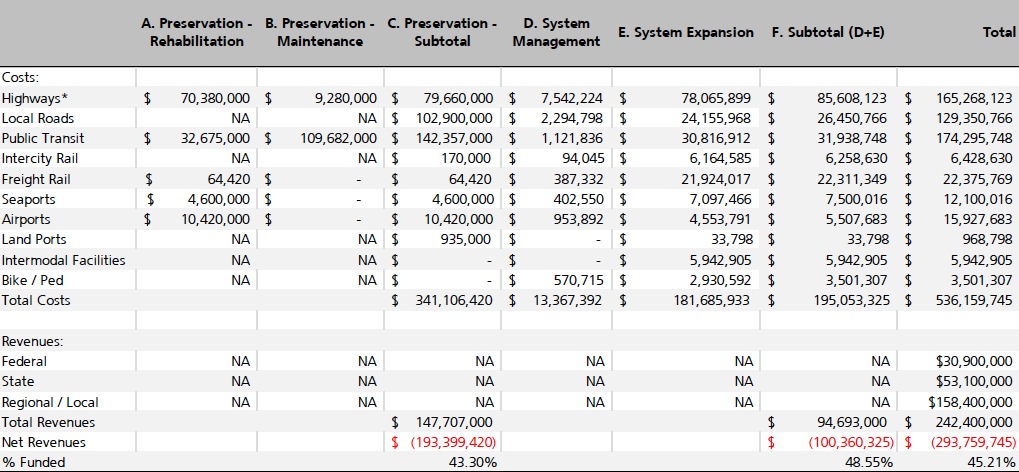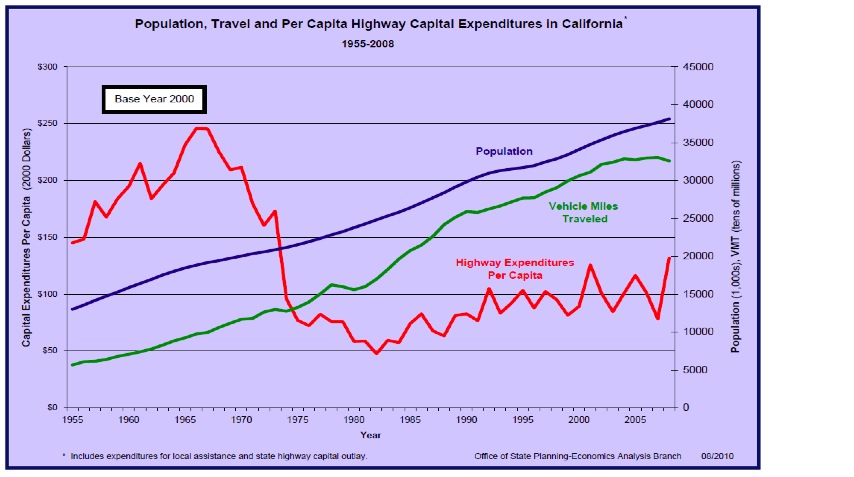CALIFORNIA TRANSPORTATION COMMISSION
Executive Summary
Background
California’s transportation system is the largest and most complex in the nation. Historical investments in freeways, roads, bridges, rail systems, airports, public transit, and other transportation infrastructure have fueled the state’s phenomenal economic growth in recent decades. But times have changed.
Today, California’s transportation system is in jeopardy. Investments to preserve transportation systems simply have not kept pace with the demands on them, and this underfunding – decade after decade – has led to the decay of one of the state’s greatest assets. Failing to adequately invest in the restoration of California’s roads, highways, bridges, airports, seaports, railways, border crossings, and public transit infrastructure will lead to further decay and a deterioration of service from which it may take many years to recover. The future of the state’s economy and our quality of life depend on a transportation system that is safe and reliable, and which moves people and goods efficiently.
These new investments are necessary at a time when the national economy is struggling to recover from the financial shocks of 2008, and when many states today, California included, face huge budget shortfalls for many programs and services. Now, more than ever, it’s critical for state governments to set clear budget priorities, and to effectively communicate what’s needed most. It is also important to recognize that funding needed transportation system improvements will positively affect California’s economy.
The goal of this report is to detail what is needed for California’s transportation system and how we can pay for it. The report, therefore, allows transportation agencies and stakeholder groups to provide a consistent message to decision makers on these important subjects.
The last needs assessment for California’s transportation system was published in 1999 for the State Senate Transportation Committee and the State Senate President pro Tempore. In 2010, the California Transportation Commission (CTC) launched an effort to update the assessment. This effort was led by the state’s Metropolitan Planning Organizations (MPOs) and Regional Transportation Planning Agencies (RTPAs). This report is the result of that effort.
One of the first steps in preparing this report was the formation of an Executive Group to oversee the work. This group included staff from the CTC; executive staff representatives from the California Department of Transportation (Caltrans) as well as several MPOs and RTPAs; and representatives from a number of other transportation agencies and stakeholder organizations. These members brought together staff resources and consultants to produce this ambitious study in a spirit of collaboration.
SUMMARY OF FINDINGS
Table 1-1 summarizes the overall results of the transportation systems needs analysis for the ten-year period from 2011 to 2020. The total cost of all system preservation, system management, and system expansion projects during the ten-year study period is nearly $536.2 billion. Of this total, the cost of system preservation projects (both rehabilitation projects and maintenance costs) during the study period is $341.1 billion. It should be emphasized that the costs for system preservation contained in the report are based on the goal of meeting accepted standards that would bring transportation facilities into a “state of good repair” within the ten- year study period. These goals would lead to higher levels of investment in system preservation than are typically reflected in existing transportation plans and capital improvement programs.
The cost of system management projects and system expansion projects over the same period is estimated at $195 billion; these cost estimates are taken primarily from adopted Regional Transportation Plans (RTPs), which are “fiscally constrained.” This means that the number and types of projects are limited to those for which revenues can be reasonably identified during the planning period.
The total estimated revenue from all sources during the ten-year study period is $242.4 billion. This represents about 45 percent of the overall estimated costs of projects and programs that were identified in the needs analysis, and leads to a shortfall of about $293.8 billion over the ten-year period. If it is assumed that revenues for preservation (rehabilitation and maintenance) are provided at historical levels (43.4%), then the amount of revenue available for system expansion and system management projects during this period is $94.7 billion, or only about 49 percent of the estimated costs of needed projects.
In addition to the transportation systems summarized in Table 1-1, this report also addresses the needs of California’s new high-speed rail system.
Over the next ten years, Phase 1 will include the construction of about 520 miles of rail between San Francisco and Anaheim. When completed, Phase 1 will provide 2-hour-and-40-minute nonstop service from San Francisco south to Los Angeles. The estimated cost for this phase, which would be completed by 2020, is $42.6 billion. The estimated available revenue for the project as of June 2011 is $6.3 billion, including $3.5 billion in federal funding and $2.8 billion in state funding.
This report also includes an analysis of the transportation needs of Native American tribes in California. This analysis is limited in scope because Caltrans did not receive adequate survey responses from Native American communities in the short time available. As a result, more research is needed.
Download full report (PDF): 2011 Statewide Transportation System Needs Assessment
About the California Transportation Commission
www.catc.ca.gov
“The California Transportation Commission is an independent public agency dedicated to ensuring a safe, financially sustainable, world-class multimodal transportation system that reduces congestion, improves the environment, and facilitates economic development through the efficient movement of people and goods.”
Tags: CA, California, California Transportation Commission, Caltrans, CTC, HSR








 RSS Feed
RSS Feed